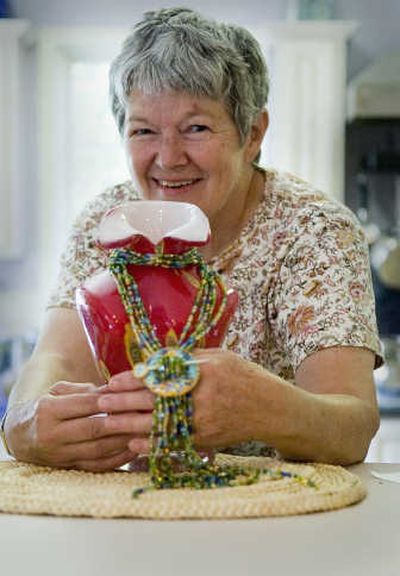Beadspinner becomes breadwinner

Judy Gilmartin began beadwork 18 years ago after retiring as a research chemist. Little did she know her hobby would develop into a new career.
“It was one of those hobby-businesses which very quickly became a real business,” says Gilmartin. “It took off, and I started doing some major advertising.”
Gilmartin sells her wares primarily from her Web site, and also at shows and the occasional open house. Her products include bead kits and tools, beads, jewelry, belts and hats. But her biggest seller is her own smaller version of the beadspinner, which earned her the name of The Beadspinner Lady.
“The Czechoslovakians really developed the beadspinner maybe a hundred years ago,” says Gilmartin. “So I sort of adapted. I first saw this size coming from France, but then they closed the factory. So I had them made locally. And the basic, low-cost version I have made in China.”
A beadspinner looks like an upside-down top with a groove. Pour beads into the groove. Place a threaded needle into the beads. Spin the beadspinner, and through centrifugal force the beads climb the needle. Tilt the needle so the beads slip down the thread. The method is much faster than painstakingly hand threading each bead.
The beads can be used as a single string, or slip stitched into a tube shape to create thicker strands.
“I get my beads from all over the world,” says Gilmartin. “These flamework beads are made by friends and acquaintances in the U.S. The really good little beads are primarily made in Japan. I have an African trader who comes here to the house, though trade beads are not very popular right now. But he brings me the nicest stuff.”
Gilmartin took a few wire wrapping classes early in her career, and still enjoys learning new techniques such as kumihimo, the ancient Japanese art of braiding cords and ribbons. She adapts this technique to her beadwork.
“Beads are one of the oldest things in the world,” says Gilmartin. “People were adorning themselves practically from day one.”
Gilmartin is fascinated by the different sizes and materials of beads. Her favorite piece, a necklace with a single silver bead depicting a hen, is not even one of her own creation.
“Well, I sort of made it,” says Gilmartin. “A friend made the basic bead here. And at my stage of life the little red hen has a great deal of meaning. What I did was put together some metal beads from Thailand, and a pin, and a handmade chain.”
Gilmartin’s doesn’t mind that her hobby became a passion for beading.
“It’s a good break. It’s a lot of fun. I like doing what I’m doing. I have all these ideas,” says Gilmartin. She points to her rooms well-laden with bead paraphernalia. “And you can see I have stuff to make everywhere! I don’t want to stop – I’m not ready to quit yet.”